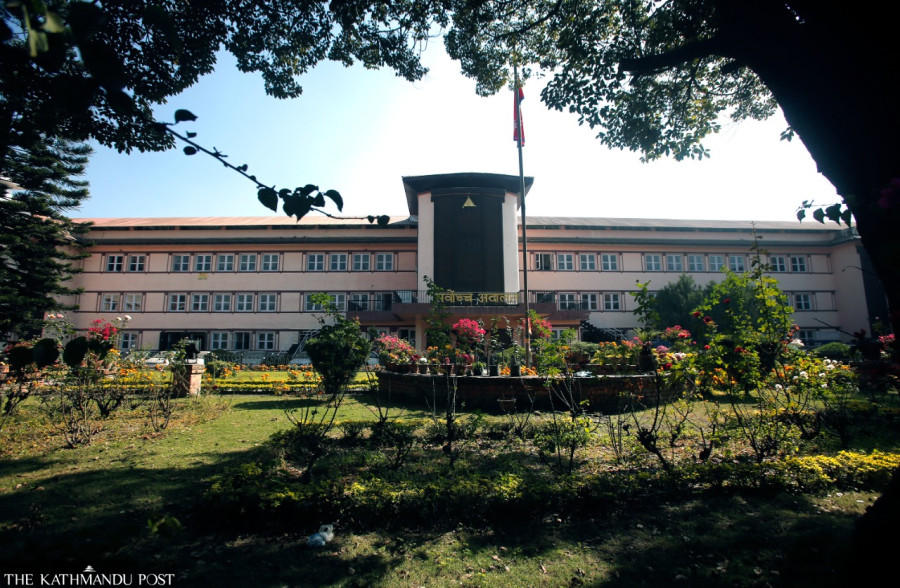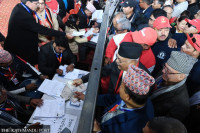National
What’s the lottery system for assigning cases and does it really work?
Justices’ protest against Rana may end when they start getting to hear petitions by drawing lots, but this process has its own complexities and is easier said than done.
Binod Ghimire
A full court of the Supreme Court has endorsed a draft to revise the existing regulations and a directive to adopt a lottery system to assign cases to justices, marking an end to the prerogative enjoyed by the chief justice to prepare the cause list.
When Supreme Court justices on October 25 launched their protest against Chief Justice Cholendra Shumsher Rana, one of their demands was that cases should be assigned to benches through a lottery system.
As per the long-standing tradition, the chief justice was assigning benches to justices—currently 19 in the Supreme Court. The justices’ protest then was supported by the Supreme Court Bar Association and the Nepal Bar Association who now are saying they are not going to relent until the chief justice steps down.
The justices, however, are of the view that they would hear the cases once the lottery system is introduced. At least five justices have already started hearing cases from Tuesday.
Now that the regulations for implementing the lottery system have been introduced, justices are set to return to benches to hear all kinds of cases. Dissenting justices had made recommendations to this effect on Wednesday.
Once the new system is adopted, Nepal would be the first country, at least in South Asia, to have such a provision to prepare the cause list.
“The lottery system will end Rana’s foul play in finalising the cause list,” a justice told the Post who did not wish to be named.
Justices and lawyers have been demanding that there should be an automated system to assign cases. But until such system is put in place, there should be a lottery system, they have demanded.
“As of now, the chief justice has been fixing benches based on the cause list provided by the case management committee,” Baburam Dahal, spokesperson for the Supreme Court, told the Post. “This will be done through the lottery system once the regulation is amended. The full court has opened the door for it.”
A Supreme Court justice said another full court meeting will decide when to introduce the new system.
Thursday’s full court meeting was one of a kind as the chief justice was not present.
“Until the next full court meeting decides the time to implement the system of drawing lots, we will only hear general cases... like minor cases,” said a justice.
But what exactly is the lottery system and how will it be implemented?
The justices involved in endorsing the draft and directives say the cause list management team will prepare a list of cases.
The daily cause list will be prepared on the same day incorporating other cases of high priority on the weekly cause list. All the cases will be grouped into different blocks based on their nature and the numbers and types of benches to be constituted for the particular day.
The weekly cause list of the cases to be heard for the upcoming week must be presented by Tuesday to the chief registrar. Such a list would be prepared “giving due priority” to the cases that are pending for a long time.
The benches will be constituted by drawing lots, which will be done every day at 10am in the presence of the chief justice, justices, chief registrar, officials from the case management committee and technicians from the information technology department.
An extended full bench, a full bench, a single bench and division benches will be constituted based on the need, which will have different boxes for tokens to be picked by the justices.
The extended full bench will be constituted first, if necessary, and then other benches will be constituted.
For instance, if an extended full bench of seven justices is to be prepared, tokens for all the present justices will be kept in a box. However, the bench will be constituted of justices who pick the numbers from one to seven. The tokens will be picked based on justices’ seniority.
The remaining justices will constitute other benches. And a representative (a justice) from each bench constituted through the draw will choose a block of cases categorised by the case management committee.
The entire process will be under the surveillance of a close circuit television camera. Officials from the information technology unit will publish the list of benches and cause list accordingly.
Though justices say the reforms in the Supreme Court will start with the end to Rana’s prerogative power to fix the cause list, they themselves are not sure how the lottery system or the so-called automated system of assigning cases works.
“The benches will be fixed by drawing lots. But I cannot explain how it will really work,” one of the justices told the Post.
The justice, who is in line to become a chief justice, said the move to end Rana’s prerogative in finalising the cause list will also end the prerogative of the chief justices who will succeed him.
Experts say the lottery system is the result of a desperate move to end Rana’s malpractices. But it does have its own demerits, they say.
Balram KC, a former Supreme Court justice, said he can barely recall any other country which practises such a system for assigning cases to justices and benches.
“But other countries do not have a chief justice like Rana whose integrity has been publicly questioned,” KC told the Post. “The chief justice assigns cases to justices in countries where the common law system prevails. There is also a practice in many countries in which a group of senior justices do such jobs.”
The initiatives to introduce the lottery system comes at a time when justices are keen on it and lawyers have stepped up their protest. Members of the Nepal Bar Association and the Supreme Court Bar Association now have made Chief Justice Rana’s resignation their bottom line, even as justices are seeking a middle path through the lottery system.
At least seven lawyers, including Chandeshwar Shrestha, chair of the Nepal Bar, were injured on Thursday in a scuffle with police on the premises of the Supreme Court.
The Nepal Bar Association has issued an ultimatum to Rana to step down by Friday.
Though Shrestha, the Nepal Bar chair, said that the return of justices to benches won’t affect their ongoing struggle against the chief justice, lawyers are concerned if that could weaken their ongoing struggle.
“But how will the justices hear the cases without lawyers?” said Shrestha.
The lottery system at present, however, appears to be the middle path for justices, as they had come under moral pressure for not hearing cases for three weeks. Despite growing calls for Rana to resign, he maintained that he would rather face the constitutional process, meaning an impeachment motion.
The chief justice can be impeached by Parliament for which parties need to make a move. But neither the ruling alliance, which consists of five parties, nor the main opposition CPN-UML has shown any interest in moving an impeachment motion.
For now, the lottery system could bring the justices back to the benches.
The introduction of the lottery system may help ease the ongoing crisis in the judiciary, but there are concerns if this could make justice delivery more effective and rid the Supreme Court of all the ills.
“Landmark verdicts are not possible through the lottery system because justices won’t get to hear cases in which they have the expertise,” KC told the Post. “But for now, this appears to be the way to get rid of Rana and the malpractices that have thrived under his watch.”
Tika R Pradhan contributed reporting.




 20.12°C Kathmandu
20.12°C Kathmandu















